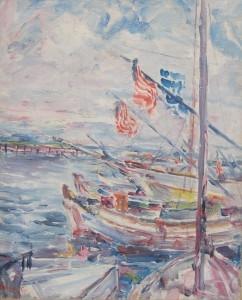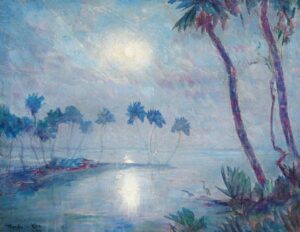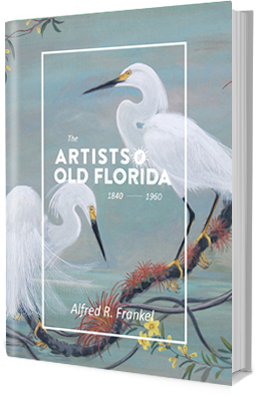Theodore Coe was, in his time, a well-known American impressionist, later recognized as one of the world’s foremost art experts on the identification and restoration of Old Master paintings. Born in 1866 on the family farm in Suffern, New York, just 40 miles north of New York City, at the age 16 Coe sought out artist George Inness for advice on his work. It was George Inness Jr. who admitted him to the house and the studio where father and son were at work. Later when Coe came to Florida, friendship with the younger Inness was renewed and Coe was a frequent visitor at the artist’s home on the Anclote River.
Before the turn of the 19th Century, like many young artists of the time, he sought out advanced training in Europe, studying art in England, Italy and Paris at the Academy Colarossi. A friend and student of the American impressionist John Henry Twachtman, Coe exhibited widely on Cape Cod, in Boston and New York before coming to Florida in 1919.
Coe spent six months in Florida and six months at East Sandwich on Cape Cod. In 1926, at the age of 60, he moved permanently to a studio in the south Tampa neighborhood of Villa Rosa, not far from Ballast Point.
A review of Coe’s exhibit at the Albertson Library in Orlando found in the Orlando Star, January 13,1926 reads: “Among the pictures with most attraction for Florida eyes was one of the sponge boats of Tarpon Springs. As for Inness, this corner of Florida seems to hold an appeal for Coe, but where Inness painted a group of Tarpon Springs homes in the quiet light of the early morning, Coe chose the picturesque boats, color splashed romantic, riding at anchor in a harbor that might be of the old world. There is another painting of Florida that will recall warm days on the east coast, a typical vacation time scene. It is a picture of a lone palm with wind shaking the long leaves and surf pounding its roots. ‘Florida Coast,’ as with a number of other paintings, must be viewed from a distance to be appreciated. There is a stretch of sand with blue sea merging into green sea and green sea merging into a light haze that means dawn cannot be far off. The colors are exotic. There is something exotic about every one of the paintings. The colors are tropical colors, tropical in their vividness, in their warmth.”
At the annual dinner of the Tampa Art Institute on June 6, 1931, Coe and his wife were guests of honor. He twice served on the jury of selection and award for the Florida Federation of Art and was a member of the jury which selected artists to execute a series of historical murals for the Florida pavilion at the Chicago Century of Progress, 1933-1934. In 1934 Coe was working for the United States government as a member of the director’s committee of the Florida Federal Emergency Relief Administration. In 1937 Coe restored a portrait of Colonel John Williams, co-founder of the city of St. Petersburg, and presented it to the city.
A member of the Florida Federation of Art, the Boston Art Club and the Salmagundi Club in New York, Coe devoted his later years to the restoration of Old Master paintings. Just before his death in Tampa in 1958, the Museum of Fine Arts in St. Petersburg presented a retrospective of Coe’s work. Lee Malone, director of the Museum said of Coe: “The rediscovery of Theodore Coe as a genuine American impressionist-one of that small early band who were much admired by their peers but never quite successful with the public-brings the reward of belated satisfaction…. I had remembered these fresh and sprightly works for many years. It was, in fact, in the middle nineteen thirties that I had first visited his Tampa studio to see them. In these vivid landscapes, especially the tropical scenes of Florida, Coe challenges the usual limitations of the thick oil medium with an immediacy more like the brilliance and dash of watercolor…. His art was adventurous and exploratory: he looked at nature with an eye of discovery and like all the sons of the nineteenth century he saw a transcendental quality in light and in landscape. His best paintings are closer to the Fauves and the quieter German expressionists with which they are contemporary. But wide public acceptance of this style was a long time in coming. In the end, connoisseurship consists in the ability to see and discern the best in a body of work, and among those who were painting in his lifetime, the light of Theodore Coe still shines brightly.”
Born: April 13, 1866, Suffern, New York. Died: August 10,1958, Tampa. Education: Cooper Union; National Academy of Design; Brooklyn Art Guild; Academie Colarossi, Paris; John Twachtman; Menard in Paris. Membership: Boston Art Club; Florida Federation of Art; Society of The Four Arts. Exhibits: Doll & Richards Gallery, Boston, 1920 to 1926; Art Center, New York City, one man show, 1925 to 1929; Museum of Fine Arts, Boston, one man show; Boston Art Club; Orlando Art Association, Albertson Public Library, January 13-31, 1926, one man show, oils, Sand Dunes near St. Augustine, Back of the Sand Dunes, Florida Lagoons, Florida Jungle, Sponge Boats- Tarpon Springs, Fruit, Where Coconuts Grow, Lone Pine, Haunts of The Blue Heron, Poinsettia in The Jungle, The Marsh in Autumn, Coconut Palms on the Coast, Coconut Forest, Orange Grove, pastels, Bit of Florida Coast, The Sea, In-coming Tide, From My Window-St. Augustine, Anastasia Island; Orlando Art Association, one man show, Albertson Public Library, January 1928; Florida Federation of Art, committee of selection for 1932 annual circuit, Jacksonville, 1930 with Henrich Pheiffer; Art Club of St. Petersburg, January 1933, one man show; Sarasota Art Association, annual, John and Mable Ringling Museum of Art, March 1938, judge; Clearwater Art Museum, February 1936; Society of The Four Arts, 4th Annual Members Exhibit, Palm Beach, March 1942, Spring Morning in Virginia; Florida Gulf Coast Artists Group, nationwide circuit, Miami to Wisconsin, Newark, San Francisco, Syracuse, 1944, Spring Morning in Virginia; National Academy of Design, New York City; New York Gallery, one man show; Retrospective; Museum of Fine Arts, St. Petersburg. Directory: Listed in the Tampa City Directory 1950 to 1953, 1955 as an artist with studio at 3015 Villa Rosa Park.





